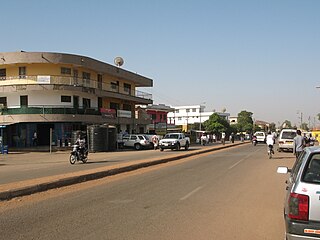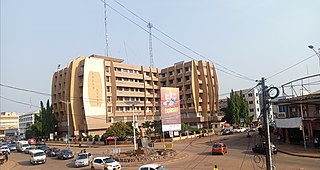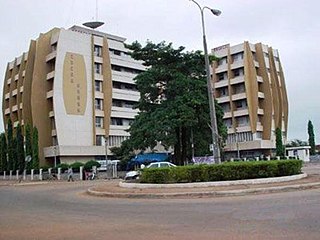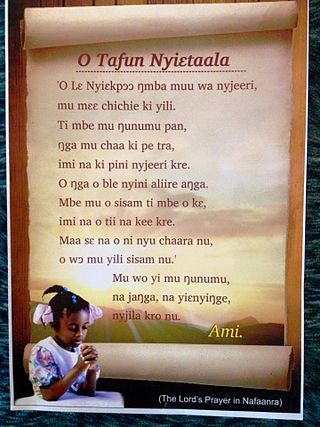
Bolgatanga, colloquially known as Bolga, is a town and also the capital of the Bolgatanga Municipal and the Upper East Region of Ghana. It share's a border to the north with Burkina Faso. Bolgatanga is 161 km (100 mi) to the north of Tamale. The town lies in the Red Volta Valley, with the White Volta and the cliffs of the Gambaga escarpment to the south of the town forming the southern boundary of the Upper East Region. As of 2021, the town has a population of about 142,509 people constituting females (74,659), representing 52.4 percent than males (67,850) constituting 47.6 percent. Some ethnic groups who lived in large qualities in Bolgatanga are Frafra, Daghati, Akan, Ewe, and Ga-Adangbe. The current mayor of the town is Rex Asanga.Bolgatanga Municipal's population in 2021 was with more females (74,659), repre- senting 52.4 percent than males (67,850) constituting 47.6 percent. The Municipal occupies a land size of 334 Km2 with a population density of 418.7 persons per square kilometre.
Techiman is a city and the capital of Techiman Metropolitan Assembly and Techiman Municipal assembly Bono East Region of Ghana. Techiman is a leading market town in South Ghana. Techiman is one of the two major cities and settlements of Bono East region. Techiman is home to West Africa's largest traditional market. Techiman has a settlement population of 104,212 people in 2013. Techiman is located at a historical crossroads of trade routes and the Tano River, and serves as capital of the Techiman Metropolitan Assembly.

The Brong-Ahafo region was a region in central Ghana. Brong-Ahafo was bordered to the north by the Black Volta river and to the east by the Lake Volta, and to the south by the Ashanti, Eastern and Western regions. The capital of Brong-Ahafo is Sunyani. Brong-Ahafo was created on 14 April 1959 from the then Western Ashanti and named after the main ethnic groups, the Brong and Ahafo. In 2019, as a result of the 2018 Ghanaian new regions referendum, the region was divided into three, namely Bono, Bono East and Ahafo regions, and ceased to exist.

Wa is a town and the capital of the Wa Municipal District and the Upper West Region of Ghana. It has a population of 200,672 people according to the 2021 census.
Sampa is a town in the Bono Region of Ghana, on the border with Côte d'Ivoire. It is the capital of Jaman North District and was formerly the site of a slave market. It was also the capital of the Akan State of Gyaaman in the late 15th century. It is the largest border town in Ghana with a population of over 36,000. It is the principal town of the Nafana ethnic group. It is the leading producer of cashews in Ghana.

Sunyani is a city and the capital of the Sunyani Municipal District and the Bono Region of Ghana. The city is located about 105 miles (169 km) southwest of Kumasi and 300 miles (480 km) away from Accra. It is the sixth largest city in the country as of the 2010 census, with a population of 75,366 people. Ethnic groups such as the Akan, Northerner, Ewe, and Ga-Adangbe resided in the city along with others. As of 2024, the current mayor of the municipality is Hon. Ansu Kumi.

Berekum, nicknamed "The Golden City", is a city and the capital of Berekum East Municipal in the Bono Region of Ghana. The city has a population of 62,364 as of 2012. The native language of the Berekum people is the Bono Twi. As of 2020, the Omanhene of the city is Daasebre Dr. Amankona Diawuo II.

Dormaa Ahenkro is a town and also the capital of Dormaa Traditional Area Dormaa Municipal of the Bono Region, in Ghana. Dormaa Ahenkro has a historical reference for their brave warlords. Dormaa Ahenkro is the capital for the Dormaa traditional area and serves as the seat of the Paramount chief Oseadeeyo Nana Agyeman Badu II.

Jaman North District is one of the twelve districts in Bono Region, Ghana. Originally it was formerly part of the then-larger Jaman District on 10 March 1989, which was created from the former Berekum-Jaman District Council, until part of the district was split off to create Jaman North District on 12 November 2003 ; thus the remaining part has been renamed as Jaman South District; which it was elevated to municipal district assembly status on 1 November 2017 to become Jaman South Municipal District. The district assembly is located in the western part of Bono Region and has Sampa as its capital town.
The Roman Catholic Diocese of Sunyani is a diocese located in the city of Sunyani in the ecclesiastical province of Kumasi in Ghana. The cathedral parish for the diocese is the Christ the King Cathedral.

Wenchi is a town and the capital of Wenchi Municipal of the Bono Region in the middle-belt of Ghana. Wenchi is located at 7.73333 [latitude in decimal degrees], -2.1 [longitude in decimal degrees] at an average elevation/altitude of 304 meters. Wenchi is approximately 30 km north of Techiman and about 50 km east of the Ivory Coast border. Wenchi has a population of 39,187 people in 2013.

The Ghana Health Service (GHS) is a Ghanaian government body established in 1996 as part of the Health Sector Reform of Ghana. It plays a crucial role in managing the country's public healthcare system. The Health Service is under the Ministry of Health . The health service primarily administers the health services in Ghana provided by the government and implements government policies on healthcare. The current Director-General of the Health service is Dr. Patrick Kuma-Aboagye who was appointed by President Nana Akufo-Addo on November 25, 2019 to replace Dr. Anthony Nsiah-Asare.
Duayaw Nkwanta is a town and the capital of Tano North Municipal District, a municipal in the Ahafo Region of Ghana. It is located close to Sunyani, the capital of Bono Region. The infrastructure of Duayaw Nkwanta is well structured. Duayaw Nkwanta has a settlement population of 27,476. This town boast of good schools such as: Boakye Tromo Senior High Technical School, Serwaa Kesse Girls Senior High School, Presbyterian Midwifery Training College among others.
Fiapre is a town in Sunyani West Municipal in the Bono Region of Ghana. Fiapre is very close to the regional capital town of the Bono Region, Sunyani.

Sunyani Municipal District is one of the twelve districts in Bono Region, Ghana. Originally created as an ordinary district assembly on 10 March 1989 when it was known as Sunyani District, until the northwest part of the district was split off to create Sunyani West District on 1 November 2007 ; thus the remaining part has been retained as Sunyani District, which it was later elevated to municipal district assembly status and has been renamed as Sunyani Municipal District on that same year. The municipality is located in the western part of Bono Region and has Sunyani as its capital town.

Banda Ahenkro is a town located in the west-northern of Bono region, Ghana, near the border of Ivory Coast. Its geography provided a home for numerous groups seeking shelter from across West Africa during the slave trade era. The original name of the settlement was Serminakuu meaning groups of 'grasses'. This name was changed to Banda, which is a corruption of 'Woanda' meaning 'they did not sleep'. Ancestors of Banda Ahenkro were allies of the Asante kingdom during wars and they provided a military force that virtually refused to sleep during at-war times. This is because they were predominantly Muslims and were found praying throughout the night. Later, 'woanda' was also corrupted by the Bono neighbours to become Banda. The settlement evolved to become the chief town or 'Ahenkro' within a collection of Nafana communities.

The Bono region is one of the 16 administrative regions of Ghana. It is as a result of the remainder of Brong-Ahafo region when Bono East region and Ahafo region were created. Sunyani, also known as the green city of Ghana, is the regional capital. Sunyani can pride itself as the cleanest capital city and a major conference destination.
Yaw Appau is a Ghanaian judge who has served as a justice of the Supreme Court of Ghana from July 2015 to August 2021.
The N12 or National Highway 12 is a national highway in Ghana that begins at the Ghana - Côte d'Ivoire border in the Western Region of Ghana and travels generally north to Hamile on the Ghana - Burkina Faso border. Its total length is 670 kilometres.
Justina Awo Owusu–Banahene, also called Awo Baatanpa, is a Ghanaian politician, educationist, and the regional minister for the Bono Region.












